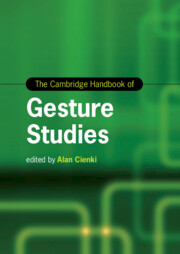Book contents
- The Cambridge Handbook of Gesture Studies
- Cambridge Handbooks in Language and Linguistics
- The Cambridge Handbook of Gesture Studies
- Copyright page
- Contents
- Figures
- Tables
- Contributors
- Introduction
- Part I Gestural Types: Forms and Functions
- Part II Ways of Approaching Gesture Analysis
- Part III Gestures and Language
- Part IV Gestures in Relation to Cognition
- Part V Gestures in Relation to Interaction
- 22 Gesturing for the Addressee
- 23 Gesture and Intersubjectivity
- 24 Variation in Gesture: A Sociocultural Linguistic Perspective
- 25 Communicative Gesturing in Interaction with Robots
- 26 Gestural Interfaces in Human–Computer Interaction
- Index
- References
24 - Variation in Gesture: A Sociocultural Linguistic Perspective
from Part V - Gestures in Relation to Interaction
Published online by Cambridge University Press: 01 May 2024
- The Cambridge Handbook of Gesture Studies
- Cambridge Handbooks in Language and Linguistics
- The Cambridge Handbook of Gesture Studies
- Copyright page
- Contents
- Figures
- Tables
- Contributors
- Introduction
- Part I Gestural Types: Forms and Functions
- Part II Ways of Approaching Gesture Analysis
- Part III Gestures and Language
- Part IV Gestures in Relation to Cognition
- Part V Gestures in Relation to Interaction
- 22 Gesturing for the Addressee
- 23 Gesture and Intersubjectivity
- 24 Variation in Gesture: A Sociocultural Linguistic Perspective
- 25 Communicative Gesturing in Interaction with Robots
- 26 Gestural Interfaces in Human–Computer Interaction
- Index
- References
Summary
This chapter reviews the study of variation in gesture and its theoretical underpinnings in the field of gesture studies. It questions the use of culture, language, or nationality as the default unit of analysis in studies of gesture variation. Drawing on theoretical developments in sociolinguistics and recent anthropologial analyses of gesture, it argues for the possibility that social factors and divisions other than linguistic/cultural boundaries may provide a more robust and comprehensive theoretical account for variation in gesture.
- Type
- Chapter
- Information
- The Cambridge Handbook of Gesture Studies , pp. 616 - 640Publisher: Cambridge University PressPrint publication year: 2024

